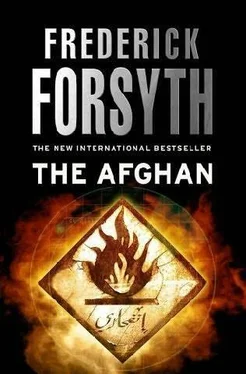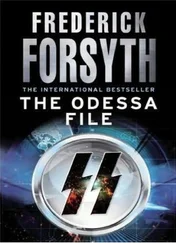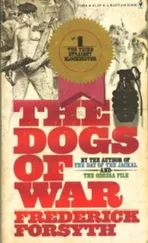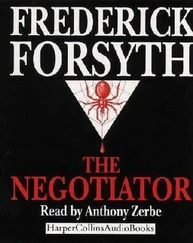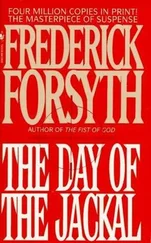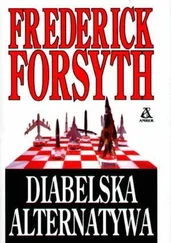Mike Martin, after a stint in Kosovo, had brought i Para to Freetown, where they were based at Waterloo Camp. After complex negotiations, five of the rangers were ransomed, but the remaining six seemed destined to be chopped up. In London, the chief of Defence staff, Sir Charles Guthrie, gave the word: Go in there and get them out by force.
The task force was forty-eight SAS men, twenty-four from the SBS and ninety from I Para. Ten SAS men in jungle camouflage were dropped in a week before the attack and lived unseen in the jungle round the bandit village, watching, listening and reporting back. Everything the West Side Boys said and did was overheard by the SAS men in the bush a few yards away and transmitted. That was how the British knew there was no further hope of a peaceful exfiltration. Mike Martin went in with the second wave after an unlucky rebel mortar had injured six, including the commander of the first wave, who had to be evacuated without ceremony.
The village-or, in fact, the twin villages of Gberi Bana and Magbeni-straddled a slimy and stinking river called Rokel Creek. The seventy SAS took Gberi Bana, where the hostages were located, rescued them all and fought off a series of manic counterattacks. The ninety Paras took Magbeni. There were, at dawn, about two hundred West Side Boys in each.
Six prisoners were taken, trussed and brought back to Freetown. A few of them escaped into the jungle. No attempt was made to count the bodies, either in the wreckage of the two villages or the surrounding jungle, but no one ever disputed the figure of three hundred dead.
The SAS and the Paras took twelve injured, and one SAS man, Brad Tinnion, died of his wounds. Mike Martin, having lost the CO of his first wave, arrived in the second Chinook, and led the final wipeout of Magbeni. It was old-fashioned fighting, point-blank range and hand-to-hand. On the south side of the Rokel Creek, the Paras had lost their radio to the same mortar blast that hit the attack leader. So the circling helicopters overhead could not report on the fall of their own mortar shells, and the jungle was too thick to see them drop. Eventually, the Paras just charged, blood pumping, screaming and swearing, until the West Side Boys, happy to torture peasants and prisoners, fled, died, fled again and died, until there were none left.
It was six months almost to the day that Martin was back in London when breakfast was interrupted by those unbelievable images on the TV screen of fully loaded and fueled airliners flying straight into the twin towers. A week later, it was plain the USA would have to go into Afghanistan in pursuit of those responsible, with or without the agreement of the Kabul government. London at once agreed that it would provide whatever was needed from its own resources, and the immediate requirements were air-to-air refueling tankers and Special Forces. The SIS head of station in Islamabad said he would also need all the help he could get.
That was a matter for Vauxhall Cross, but the Defence attache in Islamabad also asked for help. Mike Martin was taken from his desk at Para HQ^Aldershot, and found himself on the next flight to Islamabad as Special Forces liaison officer. He arrived two weeks to the day after the destruction of the World Trade Center, and the day the first allied attacks went in.
Izmat Khan was still commanding in the north, on the Badakhshan front, when the bombs rained on Kabul. As the world studied Kabul and diversionary tactics in the south, the U.S. Special Forces slipped into Badakhshan to help General Fahim, who had taken over Massoud’s army. This was where the real fighting would be; the rest was window dressing for the media. The key would be Northern Alliance ground forces and American airpower.
Without ever taking off, Afghanistan ’s puny air force was vaporized. Its tanks and artillery, if they could be spotted, were “taken out.” The Uzbek, Rashid Dostum, who had spent years in safety across the border, was persuaded to come back and open a second front in the northwest to match Fahim’s front in the northeast. And in November, the great breakout began. The key was target marking, the technology that has quietly revolutionized warfare since the first Gulf War of 1991.
Hidden invisible among the allied forces. Special Forces personnel squint through long-range binoculars to identify the enemy’s dug-in positions, guns, tanks, ammunition dumps, reserves, supplies and command bunkers. Each is marked, or “painted,” with an infrared dot from a shoulder-held projector. Via radio, an air strike is called up.
In the destruction of the Taliban army facing the Northern Alliance, these strikes either came from far away in the south, where U.S. Navy carriers hovered off the coast, or with A-io tank busters flying out of well-rewarded Uzbekistan. Unit by unit, with bombs and rockets that could not miss as they followed the infrared beam, the Taliban army was blown away and the Tajiks charged in in triumph.
Izmat Khan retreated and retreated as position after position was devastated and lost. The Taliban army of the north started at over thirty thousand soldiers, but were losing a thousand a day. There was no medication, no evacuation, no doctors. The wounded said their prayers and died like flies. They screamed “Allahu-akhbar” and charged into walls of bullets. The original volunteers for the Taliban army had long been used up. Few were left. Taliban recruiting squads had pressed tens of thousands more into the ranks, but many did not want to fight. The true fanatics were dwindling away. And still Izmat Khan had to pull them back, each time convinced that, being in the front of every combat, he could not last another day. By November 18, they had reached the town of Kunduz.
By a fluke of history, Kunduz is a small enclave of Gilzai southerners, all Pashtun, in a sea of Tajiks and Hazaras. Thus, the Taliban army could take refuge there. And it was there they agreed to surrender. Among Afghans there is nothing dishonorable in a negotiated surrender, and, once agreed, its terms are always honored. The entire Taliban army surrendered to General Fahim, and Fahim accepted.
Inside the Taliban were two non-Afghan groups. There were six hundred Arabs, all devoted to Osama bin Laden, who had sent them there. Well over three thousand Arabs had already died, and the American attitude was that they would not weep salt tears if the rest went to Allah as well.
There were also about two thousand Pakistanis who were clearly going to be a thundering embarrassment to Islamabad if they were discovered. The Pakistani ruler. General Musharraf, had been left in not a shred of doubt after 9/11 that he had a choice: become a dedicated ally of the USA, with billions and billions of dollars in aid; or continue to support, via the ISI, the Taliban, and thus bin Laden, and pay the direct consequences. He chose the USA. But the ISI still had a small army of agents inside Afghanistan, and the Pakistani volunteers fighting with the Taliban would not stint from revealing the encouragement they had once been given to go north. Over three nights, a secret air bridge exfiltrated most of them back to Pakistan. In another covert deal, some four thousand prisoners were sold for varying sums, according to desirability, to the USA and Russia. The Russians wanted any Chechens, and, as a favor to Tashkent, any anti-Tashkent Uzbeks. The original army that surrendered was over fourteen thousand, but their numbers were coming down. Finally, the Northern Alliance announced to the world media, streaming north to cover the real war story, that it had only eight thousand prisoners.
Then it was decided to hand over a further five thousand to the Uzbek commander, General Dostum. He wished to take them far to the west, to Sheberghan, inside his own territory. They were packed into steel freight containers without food or water, and so compressed they could only stand, straining upward for the air pocket.
Читать дальше
